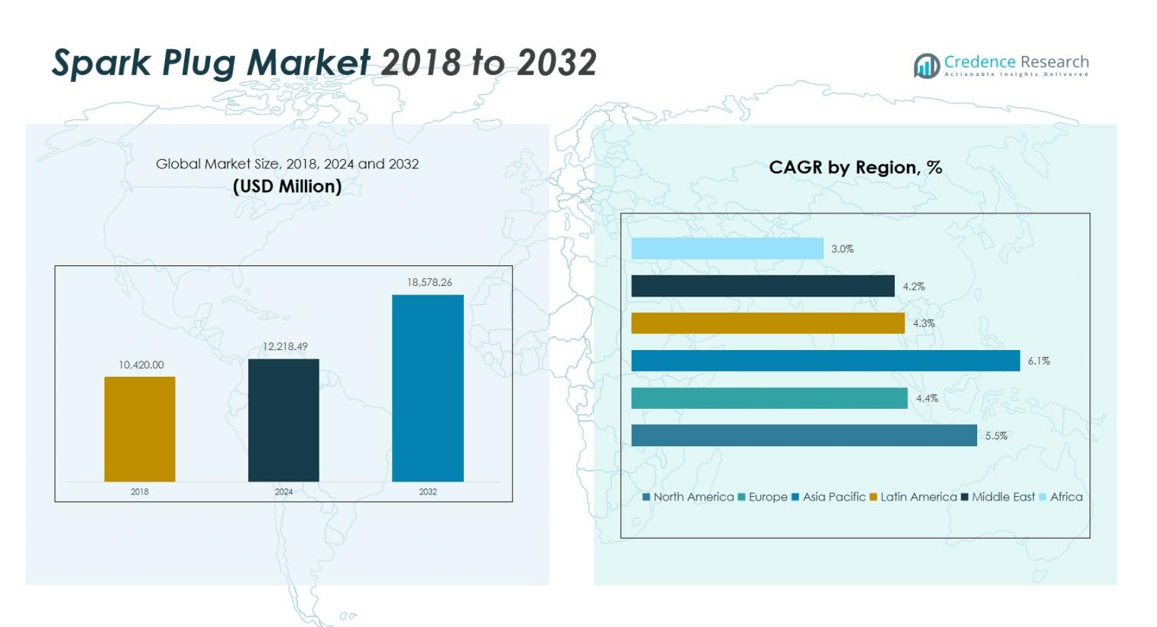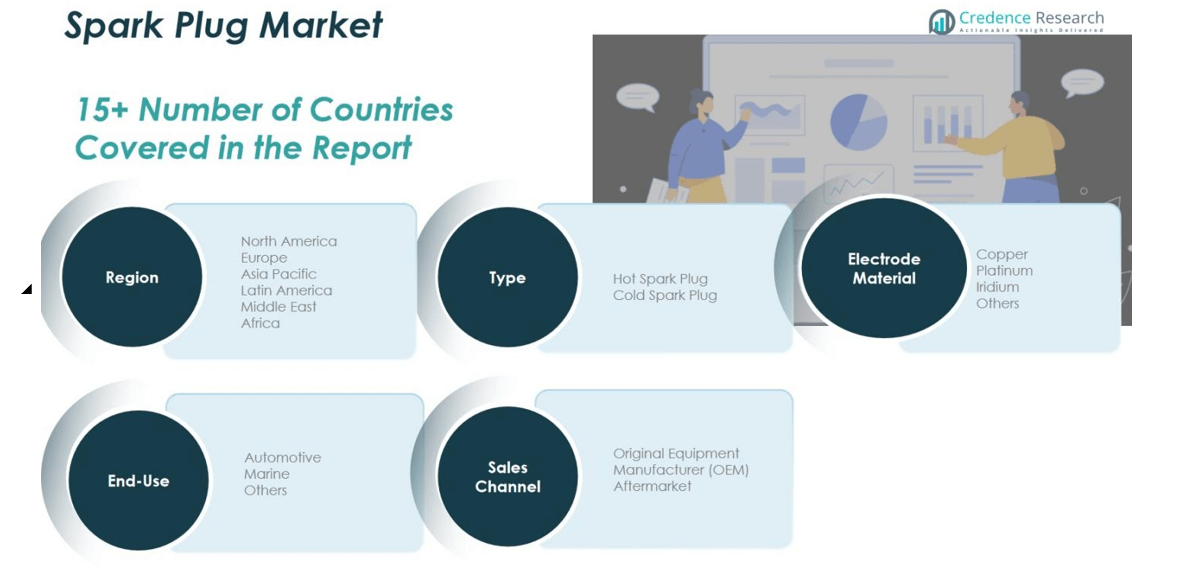CHAPTER NO. 1 : GENESIS OF THE MARKET
1.1 Market Prelude – Introduction & Scope
1.2 The Big Picture – Objectives & Vision
1.3 Strategic Edge – Unique Value Proposition
1.4 Stakeholder Compass – Key Beneficiaries
CHAPTER NO. 2 : EXECUTIVE LENS
2.1 Pulse of the Industry – Market Snapshot
2.2 Growth Arc – Revenue Projections (USD Million)
2.3. Premium Insights – Based on Primary Interviews
CHAPTER NO. 3 : SPARK PLUG MARKET FORCES & INDUSTRY PULSE
3.1 Foundations of Change – Market Overview
3.2 Catalysts of Expansion – Key Market Drivers
3.2.1 Momentum Boosters – Growth Triggers
3.2.2 Innovation Fuel – Disruptive Technologies
3.3 Headwinds & Crosswinds – Market Restraints
3.3.1 Regulatory Tides – Compliance Challenges
3.3.2 Economic Frictions – Inflationary Pressures
3.4 Untapped Horizons – Growth Potential & Opportunities
3.5 Strategic Navigation – Industry Frameworks
3.5.1 Market Equilibrium – Porter’s Five Forces
3.5.2 Ecosystem Dynamics – Value Chain Analysis
3.5.3 Macro Forces – PESTEL Breakdown
3.6 Price Trend Analysis
3.6.1 Regional Price Trend
3.6.2 Price Trend by product
CHAPTER NO. 4 : KEY INVESTMENT EPICENTER
4.1 Regional Goldmines – High-Growth Geographies
4.2 Product Frontiers – Lucrative Product Categories
4.3 Electrode Material Sweet Spots – Emerging Demand Segments
CHAPTER NO. 5: REVENUE TRAJECTORY & WEALTH MAPPING
5.1 Momentum Metrics – Forecast & Growth Curves
5.2 Regional Revenue Footprint – Market Share Insights
5.3 Segmental Wealth Flow – Type & Electrode Material Revenue
CHAPTER NO. 6 : TRADE & COMMERCE ANALYSIS
6.1. Import Analysis by Region
6.1.1. Global Spark Plug Market Import Revenue By Region
6.2. Export Analysis by Region
6.2.1. Global Spark Plug Market Export Revenue By Region
CHAPTER NO. 7 : COMPETITION ANALYSIS
7.1. Company Market Share Analysis
7.1.1. Global Spark Plug Market: Company Market Share
7.2. Global Spark Plug Market Company Revenue Market Share
7.3. Strategic Developments
7.3.1. Acquisitions & Mergers
7.3.2. New Product Launch
7.3.3. Regional Expansion
7.4. Competitive Dashboard
7.5. Company Assessment Metrics, 2024
CHAPTER NO. 8 : SPARK PLUG MARKET – BY TYPE SEGMENT ANALYSIS
8.1. Spark Plug Market Overview by Type Segment
8.1.1. Spark Plug Market Revenue Share By Type
8.2. Hot Spark Plug
8.3. Cold Spark Plug
CHAPTER NO. 9 : SPARK PLUG MARKET – BY ELECTRODE MATERIAL SEGMENT ANALYSIS
9.1. Spark Plug Market Overview by Electrode Material Segment
9.1.1. Spark Plug Market Revenue Share By Electrode Material
9.2. Copper
9.3. Platinum
9.4. Iridium
9.5. Others
CHAPTER NO. 10 : SPARK PLUG MARKET – BY END-USE SEGMENT ANALYSIS
10.1. Spark Plug Market Overview by End-use Segment
10.1.1. Spark Plug Market Revenue Share By End-use
10.2. Automotive
10.3. Marine
10.4. Others
CHAPTER NO. 11 : SPARK PLUG MARKET – BY SALES CHANNEL SEGMENT ANALYSIS
11.1. Spark Plug Market Overview by Sales Channel Segment
11.1.1. Spark Plug Market Revenue Share By Sales Channel
11.2. Original Equipment Manufacturer (OEM)
11.3. Aftermarket
CHAPTER NO. 12 : SPARK PLUG MARKET – REGIONAL ANALYSIS
12.1. Spark Plug Market Overview by Region Segment
12.1.1. Global Spark Plug Market Revenue Share By Region
12.1.2. Regions
12.1.3. Global Spark Plug Market Revenue By Region
12.1.4. Type
12.1.5. Global Spark Plug Market Revenue By Type
12.1.6. Electrode Material
12.1.7. Global Spark Plug Market Revenue By Electrode Material
12.1.8. End-use
12.1.9. Global Spark Plug Market Revenue By End-use
12.1.10. Sales Channel
12.1.11. Global Spark Plug Market Revenue By Sales Channel
CHAPTER NO. 13 : NORTH AMERICA SPARK PLUG MARKET – COUNTRY ANALYSIS
13.1. North America Spark Plug Market Overview by Country Segment
13.1.1. North America Spark Plug Market Revenue Share By Region
13.2. North America
13.2.1. North America Spark Plug Market Revenue By Country
13.2.2. Type
13.2.3. North America Spark Plug Market Revenue By Type
13.2.4. Electrode Material
13.2.5. North America Spark Plug Market Revenue By Electrode Material
13.2.6. End-use
13.2.7. North America Spark Plug Market Revenue By End-use
13.2.8. Sales Channel
13.2.9. North America Spark Plug Market Revenue By Sales Channel
13.3. U.S.
13.4. Canada
13.5. Mexico
CHAPTER NO. 14 : EUROPE SPARK PLUG MARKET – COUNTRY ANALYSIS
14.1. Europe Spark Plug Market Overview by Country Segment
14.1.1. Europe Spark Plug Market Revenue Share By Region
14.2. Europe
14.2.1. Europe Spark Plug Market Revenue By Country
14.2.2. Type
14.2.3. Europe Spark Plug Market Revenue By Type
14.2.4. Electrode Material
14.2.5. Europe Spark Plug Market Revenue By Electrode Material
14.2.6. End-use
14.2.7. Europe Spark Plug Market Revenue By End-use
14.2.8. Sales Channel
14.2.9. Europe Spark Plug Market Revenue By Sales Channel
14.3. UK
14.4. France
14.5. Germany
14.6. Italy
14.7. Spain
14.8. Russia
14.9. Rest of Europe
CHAPTER NO. 15 : ASIA PACIFIC SPARK PLUG MARKET – COUNTRY ANALYSIS
15.1. Asia Pacific Spark Plug Market Overview by Country Segment
15.1.1. Asia Pacific Spark Plug Market Revenue Share By Region
15.2. Asia Pacific
15.2.1. Asia Pacific Spark Plug Market Revenue By Country
15.2.2. Type
15.2.3. Asia Pacific Spark Plug Market Revenue By Type
15.2.4. Electrode Material
15.2.5. Asia Pacific Spark Plug Market Revenue By Electrode Material
15.2.6. End-use
15.2.7. Asia Pacific Spark Plug Market Revenue By End-use
15.2.8. Sales Channel
15.2.9. Asia Pacific Spark Plug Market Revenue By Sales Channel
15.3. China
15.4. Japan
15.5. South Korea
15.6. India
15.7. Australia
15.8. Southeast Asia
15.9. Rest of Asia Pacific
CHAPTER NO. 16 : LATIN AMERICA SPARK PLUG MARKET – COUNTRY ANALYSIS
16.1. Latin America Spark Plug Market Overview by Country Segment
16.1.1. Latin America Spark Plug Market Revenue Share By Region
16.2. Latin America
16.2.1. Latin America Spark Plug Market Revenue By Country
16.2.2. Type
16.2.3. Latin America Spark Plug Market Revenue By Type
16.2.4. Electrode Material
16.2.5. Latin America Spark Plug Market Revenue By Electrode Material
16.2.6. End-use
16.2.7. Latin America Spark Plug Market Revenue By End-use
16.2.8. Sales Channel
16.2.9. Latin America Spark Plug Market Revenue By Sales Channel
16.3. Brazil
16.4. Argentina
16.5. Rest of Latin America
CHAPTER NO. 17 : MIDDLE EAST SPARK PLUG MARKET – COUNTRY ANALYSIS
17.1. Middle East Spark Plug Market Overview by Country Segment
17.1.1. Middle East Spark Plug Market Revenue Share By Region
17.2. Middle East
17.2.1. Middle East Spark Plug Market Revenue By Country
17.2.2. Type
17.2.3. Middle East Spark Plug Market Revenue By Type
17.2.4. Electrode Material
17.2.5. Middle East Spark Plug Market Revenue By Electrode Material
17.2.6. End-use
17.2.7. Middle East Spark Plug Market Revenue By End-use
17.2.8. Sales Channel
17.2.9. Middle East Spark Plug Market Revenue By Sales Channel
17.3. GCC Countries
17.4. Israel
17.5. Turkey
17.6. Rest of Middle East
CHAPTER NO. 18 : AFRICA SPARK PLUG MARKET – COUNTRY ANALYSIS
18.1. Africa Spark Plug Market Overview by Country Segment
18.1.1. Africa Spark Plug Market Revenue Share By Region
18.2. Africa
18.2.1. Africa Spark Plug Market Revenue By Country
18.2.2. Type
18.2.3. Africa Spark Plug Market Revenue By Type
18.2.4. Electrode Material
18.2.5. Africa Spark Plug Market Revenue By Electrode Material
18.2.6. End-use
18.2.7. Africa Spark Plug Market Revenue By End-use
18.2.8. Sales Channel
18.2.9. Africa Spark Plug Market Revenue By Sales Channel
18.3. South Africa
18.4. Egypt
18.5. Rest of Africa
CHAPTER NO. 19 : COMPANY PROFILES
19.1. NGK Spark Plug Co., Ltd. (Japan)
19.1.1. Company Overview
19.1.2. Product Portfolio
19.1.3. Financial Overview
19.1.4. Recent Developments
19.1.5. Growth Strategy
19.1.6. SWOT Analysis
19.2. Denso Corporation (Japan)
19.3. Robert Bosch GmbH (Germany)
19.4. BorgWarner Inc. (USA)
19.5. Federal-Mogul Corporation (USA)
19.6. ACDelco (USA)
19.7. Autolite (USA)
19.8. E3 Spark Plugs (USA)
19.9. Magneti Marelli S.p.A. (Italy)
19.10. Valeo (France)
19.11. Hyundai Motor Company (South Korea)
19.12. Weichai Power Co., Ltd. (China)
19.13. Brisk (Czech Republic)
19.14. Enerpulse Technologies (USA)
19.15. Zhuzhou Torch Spark Plug Co., Ltd. (China)
19.16. Hella KGaA Hueck & Co. (Germany)
19.17. Pulstar (USA)
19.18. Stitt Spark Plug Company (USA)










